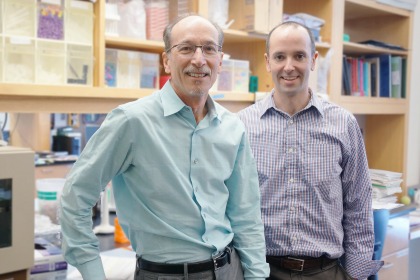Two molecular physiologists at the University of Vermont (UVM) have taken a step closer toward a possible new treatment to address the underlying root cause of familial hypertrophic cardiomyopathy, an inherited disease that causes the heart muscle to thicken and struggle to pump blood.

UVM Professor and Chair of Molecular Physiology & Biophysics David Warshaw, Ph.D., and Assistant Professor of Molecular Physiology & Biophysics Michael Previs, Ph.D. (Photo: COM Design & Photography)
Two molecular physiologists at the University of Vermont (UVM) have taken a step closer toward a possible new treatment to address the underlying root cause of familial hypertrophic cardiomyopathy, an inherited disease that causes the heart muscle to thicken and struggle to pump blood. Their latest research, published online recently in the journal Proceedings of the National Academy of Sciences (PNAS), provides insight into structural changes to a protein critical to tuning the heart’s pumping process and what might go wrong if mutated.
David Warshaw, Ph.D., and Michael Previs, Ph.D., UVM chair and assistant professor of molecular physiology and biophysics, respectively, specialize in examining the structure and function of cardiac myosin-binding protein C (cMyBP-C), one of the key controllers of the heart’s ability to properly contract and relax during each heartbeat. In their PNAS study, the researchers found that phosphorylation – or the addition of phosphate at a key link in the cMyBP-C protein chain – alters the protein’s structure and ensures that it effectively governs heart-pumping.
“We’re providing the insight, the molecular understanding of how the protein is operating,” Previs says.
In cases of hypertrophic cardiomyopathy (HCM), a frequent cause of sudden death in young athletes, cMyBP-C lacks phosphorylation, though it’s not clear why, say Warshaw and Previs, investigators in UVM’s Cardiovascular Research Institute. Without phosphorylation, cMyBP-C becomes too much of good thing; over activating each contraction of the heart muscle, which then cannot relax and fill with blood – a condition known as diastolic dysfunction.
Warshaw and Previs describe the heart using a car engine analogy. The cMyBP-C acts as the driver’s foot, regulating the pressure at which the driver steps on the gas pedal to rev up the car engine. With respect to the heart, cMyBP-C specifically enhances the presence of calcium, the heart’s analogue to gasoline, inside the trillions of microscopic cells that make up the heart.
In each of those cells, calcium allows one protein – myosin, the heart’s molecular motor – to move another protein – actin – to make the heart contract. As soon as the calcium level is high enough to trigger contraction, cMyBP-C switches its role and quickly puts on the brake, forcing myosin to release the actin, which slows down the heart’s engine so that it can refill with blood.
The scientists knew that phosphorylation played a crucial role in the operation of cMyBP-C. Their latest research shows structurally what happens: Phosphorylation changes the shape of cMyBP-C, from an elongated string of molecules to a folded, or “closed,” chain to tune its activity.
The proper levels of phosphorylation appear to help the heart muscle accelerate quickly during the contraction and then downshift smoothly when the heart is refilling. Without phosphorylation the diseased heart still functions but life’s ride isn’t so smooth, with the heart being prone to jerky stuttering movements that we all recall from our own experiences when learning to drive a car.
While the link between how the mutations in cMyBP-C lead to HCM still remains a mystery, the new study shows that, even if the protein is normal, the lack of phosphorylation leads to the same problem. The heart never relaxes. It struggles to fill with enough blood to pump adequately.
Their findings suggest the possibility of developing a new therapy, a chemical way to provide phosphorylation and, essentially, keep the engine tuned. Pharmaceutical companies are now paying attention to cMyBP-C, Warshaw says.
For Warshaw and Previs, the next step is to figure out the reason that phosphorylation changes the structure of cMyBP-C.
“To just say that it happens isn’t enough,” Warshaw says. “We want to know why it happens.”